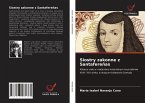The interest of this research focuses on the concern for the pictorial representation of the religious female body in colonial society, allowing us to problematize the ritual function, the social function, and the political function of the portraits of dead nuns in the New Kingdom of Granada, attributed to Victorino García, 1810. The appropriation and symbolic uses of these paintings contribute to the study of the concepts and ideological paradigms that operated in colonial society and expand the study of visual rhetorics from the relationship with art manuals and autobiographies of the nuns of New Granada. Studying the representation of the female body in colonial painting opens the interpretative sense of history, which is broken in its discursive hegemony, with the aim of interrogating the constitution of the colonial female subject from three metaphors constructed in a religious key: Virgin, Eve and Magdalene.
Hinweis: Dieser Artikel kann nur an eine deutsche Lieferadresse ausgeliefert werden.
Hinweis: Dieser Artikel kann nur an eine deutsche Lieferadresse ausgeliefert werden.








